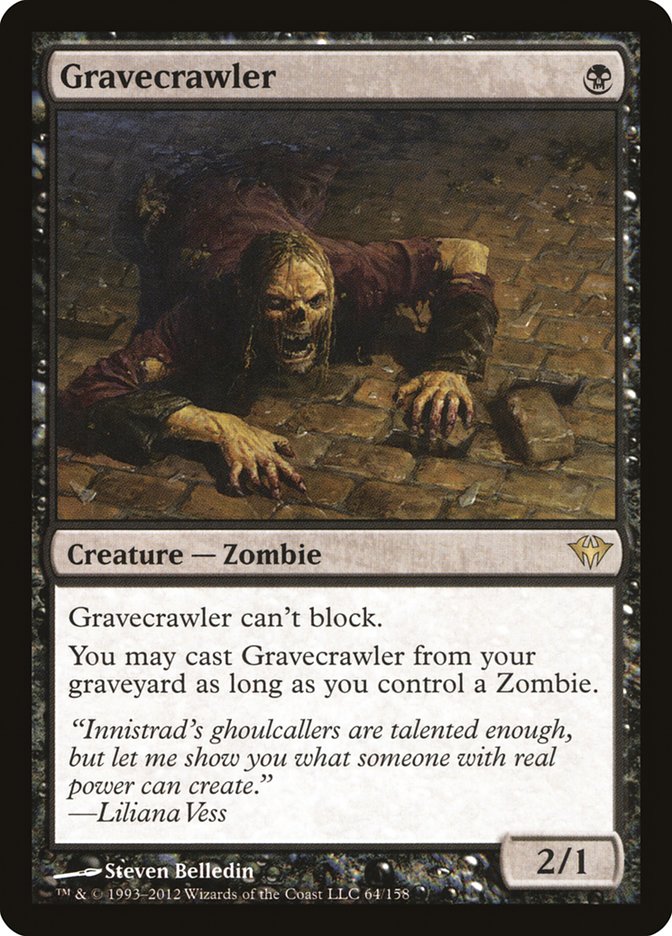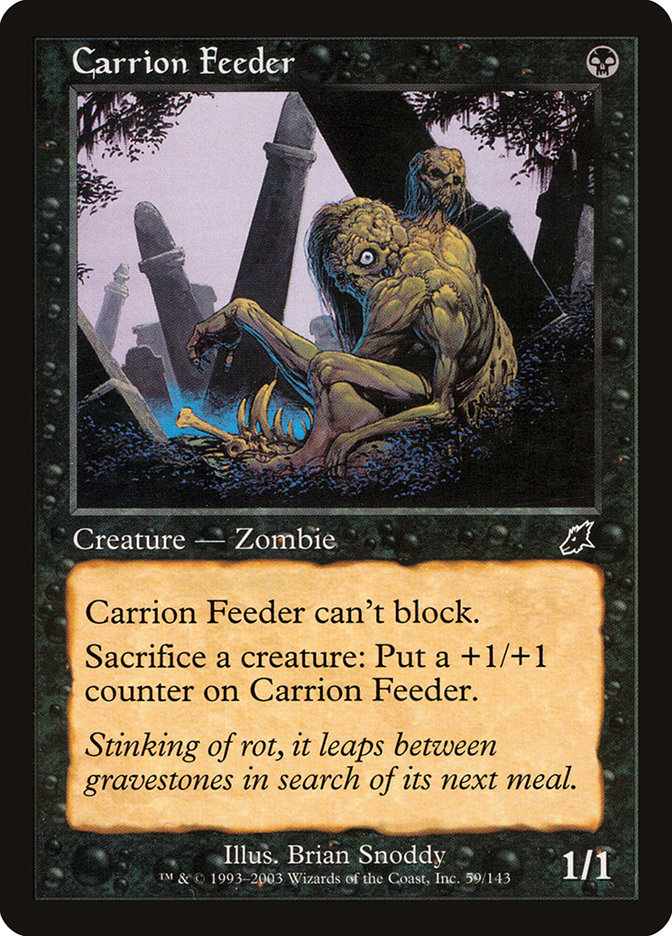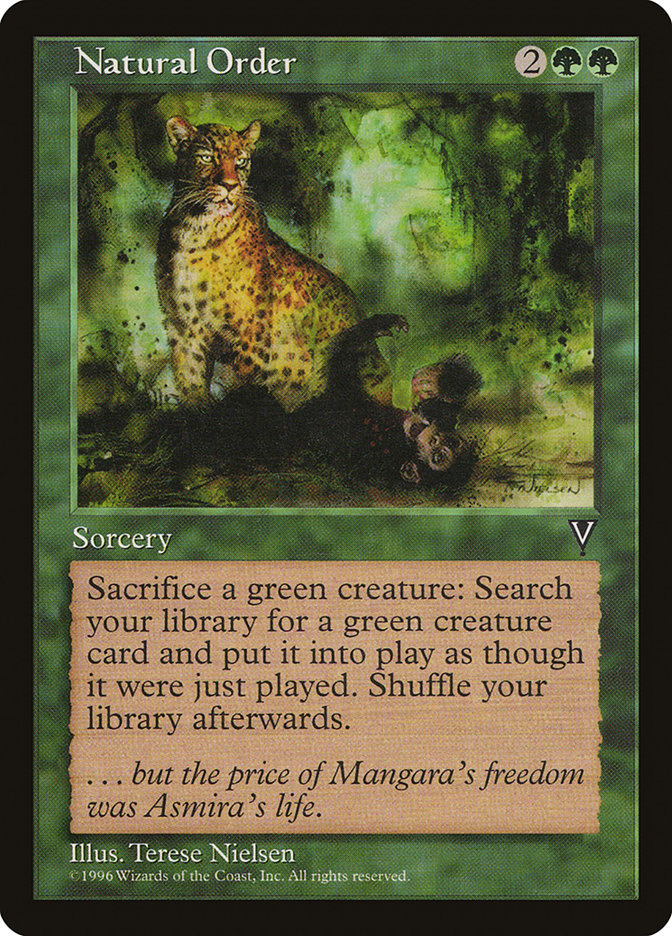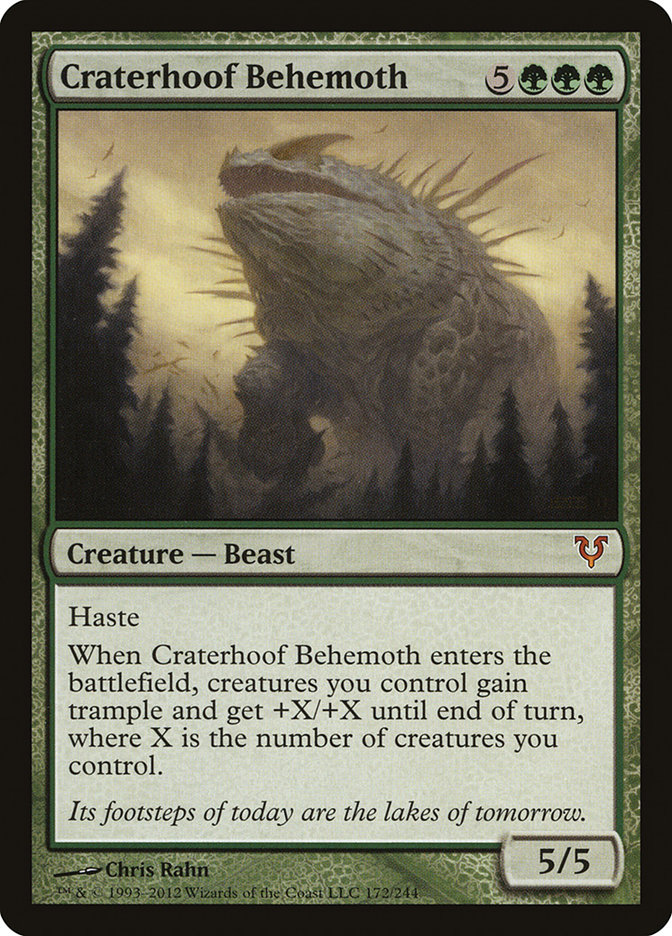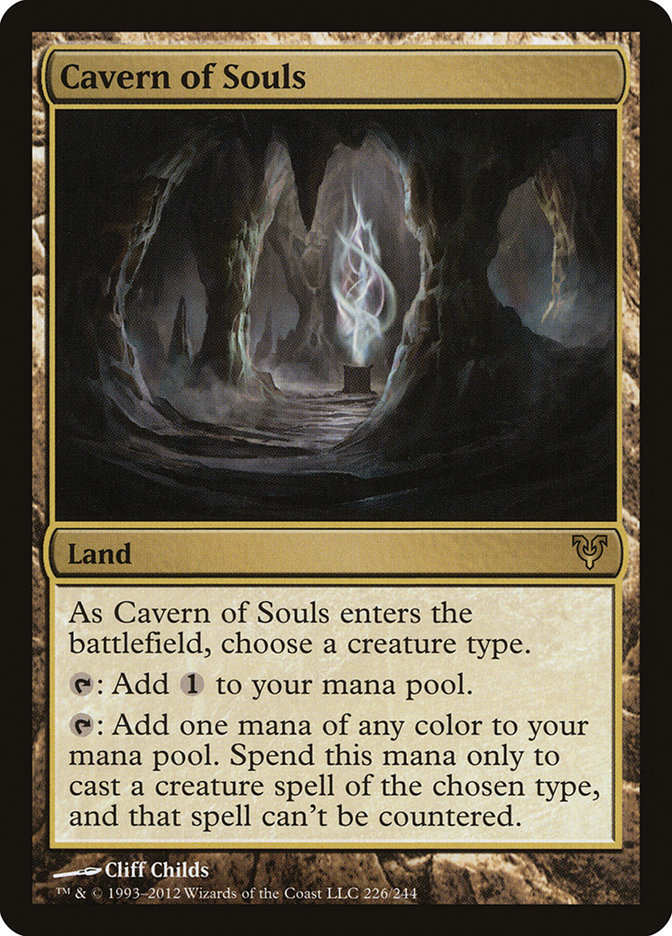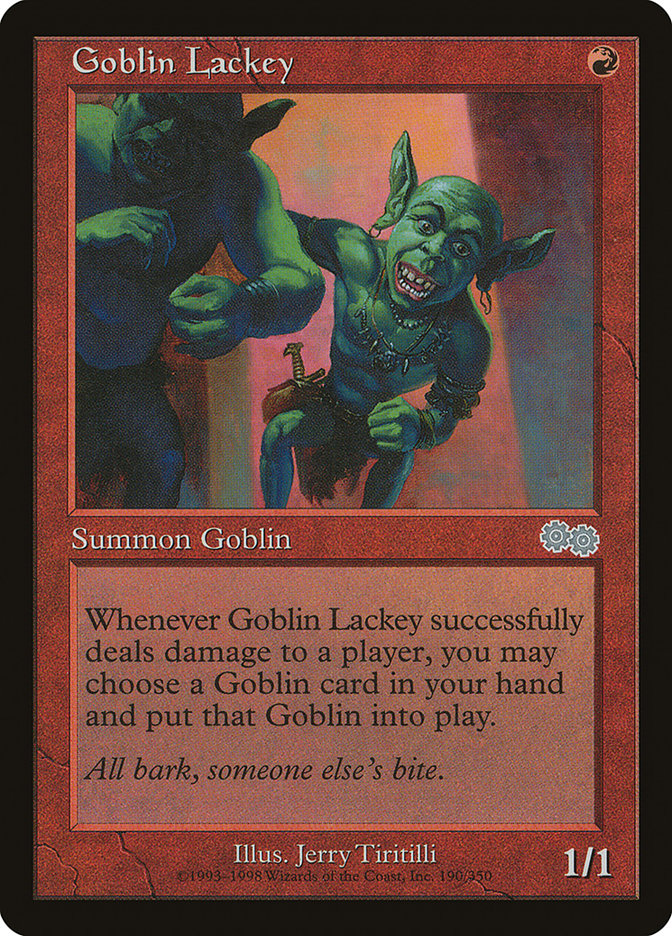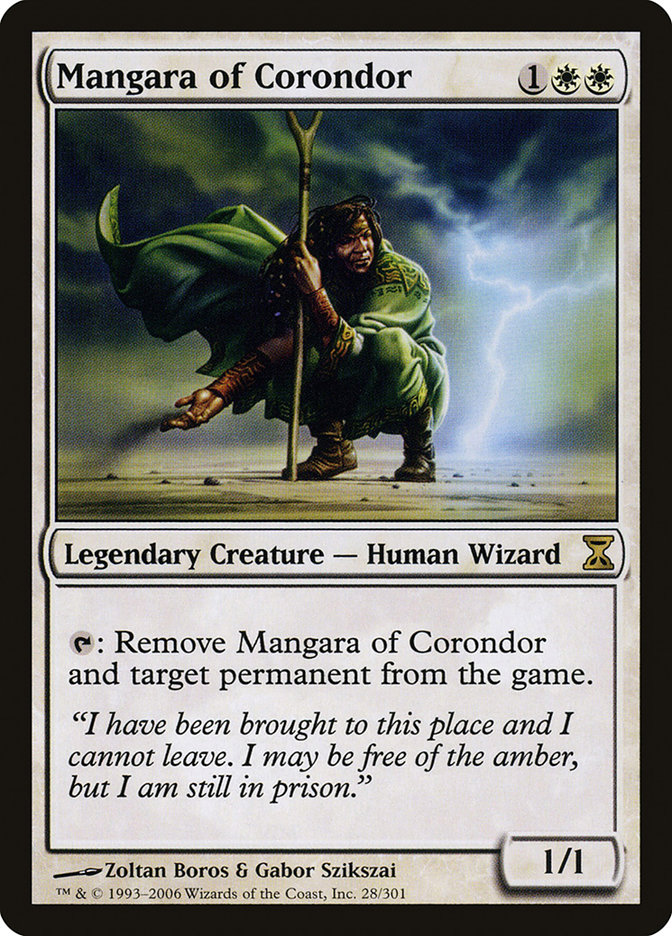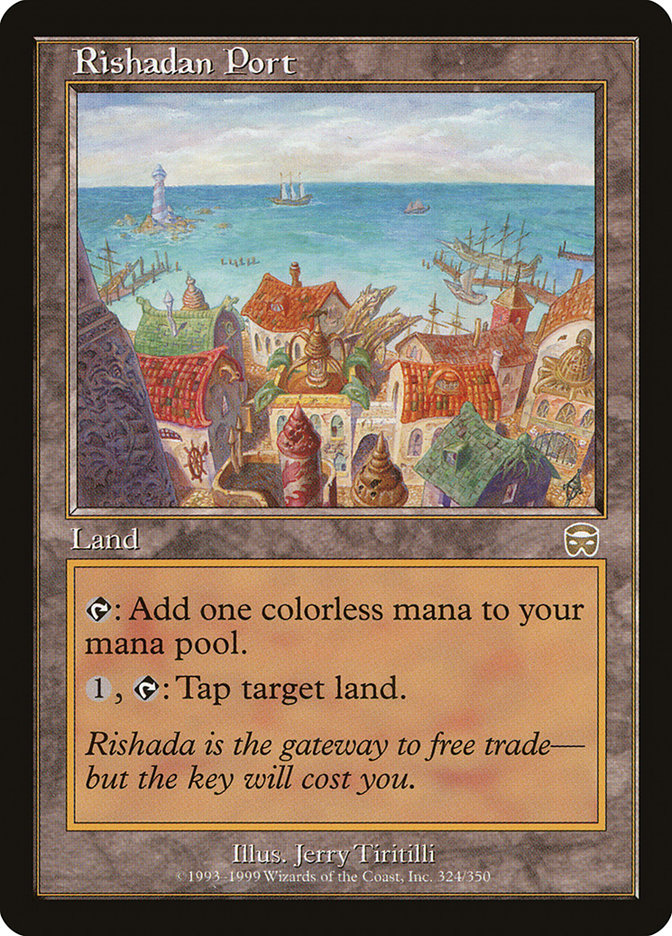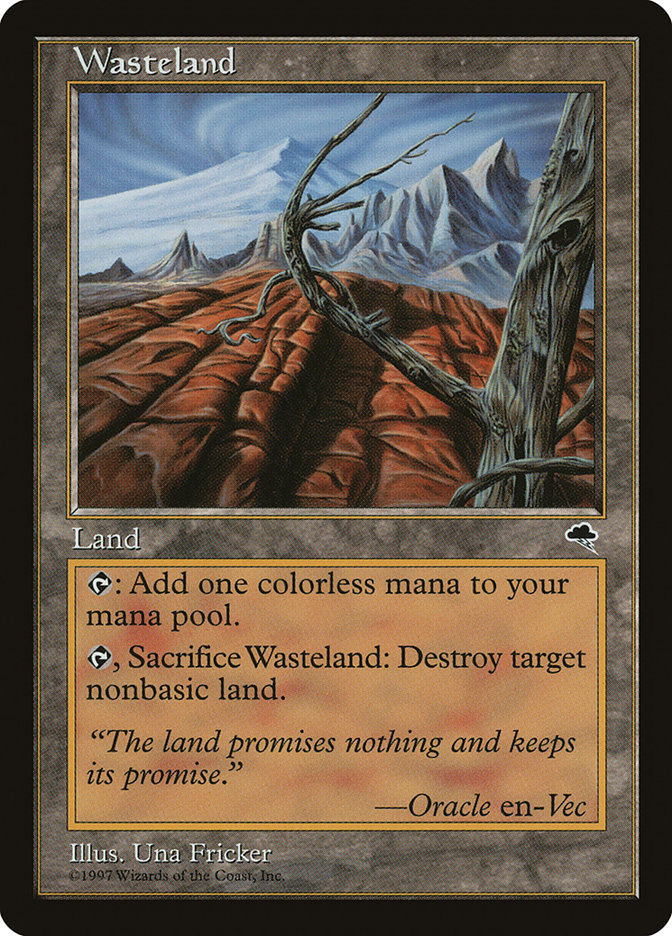Legacy is a format defined by powerful spells.
There are certainly powerful creatures in the format, but it is the cantrips and free counters and fast mana that get people talking about Legacy.
There is another side to the narrative of “Legacy players are slavishly devoted to fiddly blue decks that don’t do anything until they try to take over/win the game in the span of one or two turns.”
Some people really like Legacy because it’s the last bastion of the tribal creature deck.
Modern may have a passable Merfolk deck, but Legacy has Elves, Goblins, two different Humans decks, Merfolk, Wizards, and Zombies.
Legacy has twenty years of cards interacting with each other to create sweet things like this:
Or this:
Or even this:
Legacy really does have something for everyone. But how do these decks tend to do against the format’s boogeymen, Monday’s combo decks?
In a word, badly. Because they devote so much space to maximizing slower but more synergistic tribal interactions, they have far less room for cards that are powerfully interactive. The nonblue tribal decks tend to shoehorn a hate card in as a singleton to be tutored for. Goblins plays Goblin Matron, and Elves plays Natural Order and Green Sun’s Zenith. Both decks are still huge underdogs to a deck like Storm or Reanimator, but they have outs that they can play to. Still, the best creature decks in Legacy tend not to act like creature decks. But when is a creature deck not a creature deck?
The creature-heavy decks that have thrived in this format are not the turn-’em-sideways beatdown strategies that you came to love in high-school hallways. Beatdown decks get outpaced in Legacy by combo decks and can easily get tempoed out by hyperefficient Delver decks. If you have a three-mana 2/2 that Glorious Anthems your team and they have a Lightning Bolt to follow up a Tarmogoyf, you fall pretty far behind.
No, the successful creature decks in Legacy act like Prison-style control decks or combo decks. What does a Prison deck look like and what is it trying to do?
Creatures (11)
Lands (19)
Spells (30)
- 1 Sol Ring
- 1 Mana Crypt
- 4 Sphere of Resistance
- 3 Crucible of Worlds
- 1 Trinisphere
- 4 Smokestack
- 1 Black Lotus
- 4 Tangle Wire
- 1 Mox Emerald
- 1 Mox Jet
- 1 Mox Pearl
- 1 Mox Ruby
- 1 Mox Sapphire
- 4 Chalice of the Void
- 2 Thorn of Amethyst
Sideboard

This is a Prison control deck. It seeks to prevent the opponent from casting their spells in the way they intend to. It creates a world in which spells cost more and then uses its considerable mana base to cast its spells while its opponent flounders about trying to compete.
The mono-white Death and Taxes deck operates under a similar principle:
Creatures (26)
- 4 Mother of Runes
- 3 Serra Avenger
- 2 Aven Mindcensor
- 4 Flickerwisp
- 4 Stoneforge Mystic
- 1 Mirran Crusader
- 4 Phyrexian Revoker
- 4 Thalia, Guardian of Thraben
Lands (23)
Spells (11)

Thalia, Guardian of Thraben plays the role of Thorn of Amethyst, Rishadan Port costars as Legacy’s Sphere of Resistance, and Aether Vial supports both as the Mishra’s Workshop proxy. Such comparisons are by their very nature imperfect, but it is obvious that both Stax and Death and Taxes want to force opponents into suboptimal situations by attacking their capacity to cast their spells or get maximum value out of their cards.
There are no synergy-focused cards in this deck. There is neither Goblin Lackey nor Merrow Reejerey. Every card is remarkable for its ability to hold its own in a fight and bring relevant additional value to the table.
I want to discuss this list in particular because it placed Thomas Enevoldsen in the Top 4 of the recent European super-tournament Bazaar of Moxen. Enevoldsen is the reigning Legacy Grand Prix champion, having won Grand Prix Strasbourg back in April with this exact archetype. He beat his teammate, Michael Bonde, in a semifinals mirror match. I respect him very highly.
The first thing that we should talk about is the mana base. This is a mono-white deck with ten basic Plains, thirteen other lands, and four Aether Vials. It is exceptionally unlikely to get mana screwed or flooded, as it has a lot of ways to both convert lands into useful interactions and spend excess mana on its cards’ value-adds.
The deck plays three copies of Karakas, a nonbasic Plains that looks oddly out of place in a deck with only four copies of Thalia, Guardian of Thraben as a legend to protect.
Then you remember that Griselbrand and Emrakul, the Aeons Torn exist in the format.
And that people like to put them into play with Show and Tell or Reanimate.
And that those same Show and Tell or Reanimate decks tend to play cards that counter attempts to remove said legendary creatures.
And as you learned from your friend back in middle school, you can’t counter their lands.
Karakas is a very big part of why this deck is so well positioned—it can afford to play three copies of a legendary land that serves primarily to antagonize two combo decks.
Once upon a time, though, Karakas was a lot more robust. Back when the deck played four Karakases, it also played Mangara of Corondor.
The idea was that you could Vindicate their best card every turn with Mangara, Karakas, and an Aether Vial on three. The loop goes like this:
1. You activate Mangara of Corondor. Mangara’s activation cost is “tap {Mangara}.” That’s it.
2. Before the effect resolves and exiles Mangara, target Mangara with Karakas.
3. Karakas resolves, returning Mangara to your hand.
4. Mangara’s effect resolves, exiling their permanent.
5. Activate Aether Vial at some point, putting Mangara back in play.
6. Lather, rinse, repeat.
The problem is that Mangara of Corondor is pretty abysmal without Karakas. It’s fragile, slow, can’t battle, and needs Karakas to be a Legacy-playable effect. I’m happy to see Mangara out of the most recent decklist, as it just does too little on its own.
Without Mangara, the deck has cut down to three Karakases but has added a single Cavern of Souls as another way to break through RUG Delver’s wall of Dazes—naming Human resolves Mother of Runes, Thalia, and Mirran Crusader.
The Horizon Canopy is a low-cost way to play a Plains that cycles when you need another spell. If you decide to add some Enlightened Tutors to the sideboard like Ari Lax did, I would strongly recommend adding a second and maybe even a third.
Finally, we get to the all-important colorless lands. Without these, aggressive decks would likely not exist in Legacy.
Rishadan Port allows you to get maximum value out of your creatures. Your opponent may have a Supreme Verdict or a Tarmogoyf or a Show and Tell, but they’re just going to have to wait until next turn to cast it. Take three.
What’s that? You Wastelanded them? Guess they can wait another turn. Take three more.
Another Rishadan Port and they missed their land drop? Uh oh. Take three more.
Come on, aren’t they going to play spells this game? Take three.
And dead.
And even if your opponent manages to sweep you through Ports, you still have a full hand because you spent your mana Porting them, not overextending into their sweeper.
The beauty of this deck is how directly it rewards using your mana sinks. In my first game, I tapped my Ports and Wastelands for mana, didn’t get my Equipment into play, and got attritioned out by removal spells. I hated the deck and wanted to throw my computer across the room.
By my tenth game, I was killing people with five creatures left in my hand. The deck has a lot of play. This is not your typical “Savannah Lions into White Knight” deck.
Wasteland is less nuanced than Rishadan Port, as it doesn’t “feel” like a negative cost. With Port, you lose access to two mana, and they lose access to one. “How can this be good?” the mind wonders. But it’s about as good as Wasteland.
Wasteland is straightforward. I lose a land; you lose a land. Let’s see what happens.
I have an Aether Vial; you have no lands. Let’s see what happens.
A few turns later, the white deck comes out ahead again.
So what is it doing while its mana base is throwing up roadblocks?
4 Aether Vial: It’s cheating on mana costs with Aether Vial. The optimal number here is two, as the deck has four one-drops and seven three-drops yet fifteen two-drops. Until you have a Flickerwisp or Mindcensor that you want to get into play, keep your Vial on two.
4 Swords to Plowshares: You play Wasteland and Rishadan Port. You do not want to give them another land. Plow is still the best removal spell in the format. The life gain doesn’t much matter when your modus operandi is to build a dominant board position, not to build a house of cards that counts to twenty before your opponent blows it over.
4 Mother of Runes: Never attack with Mother of Runes unless you’re playing against a combo deck and you have nothing in play that you want to protect from a bounce spell. Mother of Runes has three major functions:
- Countering (or realistically threatening to counter) their removal spell
- Giving your best attacker evasion
- Granting protection from an attacker’s color to a blocker
Mother of Runes acts as a Flagbearer early. If they have Swords to Plowshares or Lightning Bolt, they’re very likely to just dispatch her with that when they have the chance. This can be a huge benefit since it often means throwing your opponent off curve for a turn, which is all you need to seize the initiative and start committing threats to the board.
When they don’t have a removal spell but draw one later, it’s dead. It’ll trade for a single Mother of Runes activation, meaning they have to lure you into using Mother of Runes on a potentially advantageous interaction before they can cast their removal spell in response.
This, of course, has a follow-up: do they target your Mother of Runes or your threat with their one removal spell? That decision is far more situational, but you can expect a good percentage of opponents to err in that moment.
In conclusion, don’t ever cut any number of Mother of Runes. Even against combo decks, you can use Mother of Runes to protect a hate bear from a sideboarded removal spell, buying you more time to finish them off. Speaking of hate bears . . .
4 Thalia, Guardian of Thraben and 4 Phyrexian Revoker: These are how you beat combo decks. Thalia also happens to be beyond incredible against Delver, as she cuts off their greatest advantage: the ability to play multiple spells in a turn. Without that, they are a woefully slow and underpowered deck that is easily dismantled by creatures with abilities that dominate combat. You know, abilities like flying, protection from green, or first strike. Storm is almost completely kold to a resolved Thalia, if you’re ever wondering whether to cast it on turn 2.
Phyrexian Revoker is either your best card or your worst card. If you have something good to name, it’s incredible. It shuts down the linchpin of their strategy, it attacks for two, and their deck does nothing.
A list of cards to name against various decks by priority follows:
- Storm: Lion’s Eye Diamond, Lotus Petal
- Sneak and Show: Sneak Attack, Sneak Attack again, Griselbrand
- Reanimator: Griselbrand
- Miracles: Jace, the Mind Sculptor or Sensei’s Divining Top depending on the board
- Elves: Heritage Druid, Wirewood Symbiote (these two can trade places depending on how close they are to a Glimpse of Nature turn), Quirion Ranger
- Shardless BUG: either of their planeswalkers situation depending
- Jund: Liliana of the Veil
- Stoneblade decks: Umezawa’s Jitte (it’s far better against you than for you)
If you don’t have something to name, it’s a Goblin Piker in a format where Tarmogoyf is legal, so it’s first on the chopping block when sideboarding comes around.
4 Stoneforge Mystic: The best white creature in Legacy. The Equipment that Stoneforge Mystic finds is a great way to improve your board position without actually committing more creatures to the board. Batterskull is also an excellent standalone threat and one that tempo decks have to deal with before it hits play. This makes Stoneforge Mystic yet another kill-on-sight creature against tempo decks, further straining their sparse five-to-six removal spells.
Against midrange decks, Batterskull is also a sort of inevitability—unless they can Maelstrom Pulse it while you’re tapped below three mana, you’ll have a recurring 4/4 Germ with vigilance and lifelink to fend off hordes of 1/2s, 2/1s, 2/2s, and 3/2s. Play to protect your Batterskull against Jund and Shardless BUG—they have relatively few ways of killing it outright, so as long as you don’t let their planeswalkers take over and don’t let them kill your Batterskull you should be able to negate a huge amount of their card advantage.
3 Serra Avenger: This card was once a stock four-of in Death and Taxes, fell out of favor for a while, and is back with a vengeance now that True-Name Nemesis is scaring people away from fairer decks. As it turns out, Nemesis isn’t quite as good against an army of fliers. Serra Avenger is best friends with Aether Vial, as its condition restricts when you can cast it but not when you can put it into play via an activated ability.
Serra Avenger is also great friends with blocking Insectile Aberration. It does that quite a bit. Since Death and Taxes tends to gum up the ground against Delver after a short while, their last angle of attack is through the air. Serra Avenger cuts off that final angle, occasionally even with the support of Mother of Runes.
4 Flickerwisp: The card that people use to make fun of the deck the most. People will inevitably refer to this deck as, “You mean the one with four Flickerwisps? That deck? Ahahahahahah!” and so on.
And then you Vial in Flickerwisp to save your creature from a removal spell and they stop talking.
And then you Vial in a second Flickerwisp, flicker your first copy, return that one in your end step, and exile their Jace, the Mind Sculptor so that they can’t use it to Unsummon your creature, which they really needed to do in order to survive.
And then the next game you Vial in Flickerwisp and flicker your Batterskull after they’ve Unsummoned the Germ, providing seven damage out of nowhere.
And then against a different opponent you Flickerwisp your Thalia after combat, use your last land to Swords to Plowshares their creature, and pass with two blockers. Good old Limited Magic, right? No room for that in Legacy, no sir!
Except when Flickerwisp happens to blow someone out. And then your opponent will respect the value of having something so nice that it’s worth doing it twice.
Everyone wants to cut Flickerwisp from this deck when they first see it. It’s the Vendilion Clique of creature-on-creature Magic, though, so probably don’t do that.
2 Aven Mindcensor, 1 Mirran Crusader: Aven Mindcensor trades with Insectile Aberration, shuts down a lot of good tutors, nerfs fetch lands a good percentage of the time, and attacks over True-Name Nemesis. Sometimes that’s all you need.
Other times you need a mushroom-cloud-laying Mirran Crusader. One that can go to work on your opponent with a pair of pliers and a blowtorch.
Enevoldsen’s sideboard is a mix of high-utility cards. He has Sunlance for small creatures, Relic of Progenitus for Tarmogoyfs and graveyard decks, and a pair of Rest in Peaces as more dedicated Relics.
He also has a mix of removal spells that can be matched to fit the circumstance. Are they putting a bunch of Elves into play? Probably take advantage of the fact that you only have four one-drops in your white creature deck and board in Ratchet Bomb against their twenty-plus one-drops.
Are they putting an Emrakul into play? Put in Oblivion Ring. Or Pithing Needle. Remember that Pithing Needle is both broader in application but narrower in scope than Phyrexian Revoker—Revoker can shut off Lotus Petal and Lion’s Eye Diamond. Try that with Pithing Needle and you’ll end up embarrassed and dead to Tendrils of Agony.
Are they casting Dark Ritual or Glimpse of Nature? Get your Ethersworn Canonists in.
Are they Hymn to Touraching you or ticking up Liliana of the Veil? Wilt-Leaf Liege has you covered.
And finally—this slot got a lot of consternation on Twitter—Cataclysm is an Armageddon that leaves you with a Karakas or a Rishadan Port, leaves them without a Jace or Elspeth or Liliana, and kills most of the Angels that they may have Entreated. It also cleans up an Elves board that has recently Glimpsed all of what Nature has to offer.
If you want to play a creature deck this weekend, I strongly recommend Thomas Enevoldsen’s Death and Taxes list.
I have some bad news for the rest of you. There are a lot of decks that were once passable choices for a Grand Prix metagame—Merfolk, Goblins, Sam Black Zombie deck—that have gotten worse with the recent spike in combo’s popularity.
It is true that True-Name Nemesis is a Merfolk. It is also true that it is a 3/1 for three in a deck filled with effectively unblockable 3/3s for three. Merfolk does not gain nearly as much from True-Name Nemesis as other decks do.
Goblins is a much worse version of Death and Taxes nowadays. Goblins suffers from the linearity problem—it plays too many cards that form a cohesive and synergistic game plan and too few cards that disrupt an opponent’s (much faster) game plan. It is an unfortunate relic of a bygone era when Legacy was slow enough to get attritioned out by Goblin Ringleader. Those days are behind us for now.
Zombies lost a lot with the printing of Deathrite Shaman, and while it has always been a decent anti-combo deck, it hasn’t kept up with the metagame as much as other disruptive base-black decks have.
Affinity, much as I love it, has a really tough time with Show and Tell. The maindeck that I wrote about in my article and videos is still fine, although I would cut the Mindbreak Traps and a Rest in Peace for either Pithing Needles, Phyrexian Revokers, or Ensnaring Bridges. Sneak and Show is still a tough matchup, so good luck if you choose that path. You can find my videos here.
That leaves Elves.
I would be lying to you if I told you that Elves is unplayable. It is not. It is very well positioned actually. It just won the Bazaar of Moxen:
Creatures (30)
- 1 Llanowar Elves
- 4 Wirewood Symbiote
- 4 Quirion Ranger
- 1 Viridian Shaman
- 1 Birchlore Rangers
- 4 Heritage Druid
- 4 Nettle Sentinel
- 4 Elvish Visionary
- 2 Craterhoof Behemoth
- 4 Deathrite Shaman
- 1 Ruric Thar, the Unbowed
Lands (20)
Spells (11)
Sideboard

Here’s the thing though.
If you’ve never played the deck before, I can’t teach it to you well enough to win a Grand Prix three days from now.
If you have played the deck before, you’re probably already better with it than I am.
While this deck is certainly a contender, the floor for competency with the deck is high enough that I would discourage nouveaus from spending a lot of time trying to master it before Saturday.
I can offer you the following pieces of advice for playing against Elves, as I played against it with many different decks:
- Wirewood Symbiote is their best creature bar none. Kill it on sight.
- Heritage Druid is a red herring. It turns all of their creatures into Llanowar Elves. That’s nice but not worth writing home about.
- If all you’re doing to interact with them is casting Lightning Bolt or Swords to Plowshares, you’re losing to Elvish Visionary. You have to have something like Golgari Charm, Punishing Fire, Forked Bolt, Fire // Ice, Rough // Tumble, Supreme Verdict, Engineered Explosives, or Ratchet Bomb. Their deck is filled with 1/1s for one.
- Spell Pierce and Flusterstorm are still good against them. Counter the first thing you can and throw whatever you have at a Glimpse if you think they have two or more creatures to play. Cutting them off from mana on a turn 3 Glimpse is basically like countering it.
- Read their cards and figure out how they’re going to sequence all of their plays. Quirion Ranger and Wirewood Symbiote both untap Deathrite Shaman, so there will be plenty of turns where they can use it twice.
- Figure out what happens if their land drop is Gaea’s Cradle. Figure out how to minimize damage from that.
- You can’t just sit around and kill their creatures without also having an answer to Progenitus. If all of your answers kill only their Elves, you’ll lose to their 10/10.
You have read this article correctly. I do not believe that creature-heavy decks are particularly well positioned right now. I do believe that Death and Taxes is well positioned due to its advantages against tempo and combo decks and the recent decline of removal-heavy midrange strategies.
I believe that Elves is well positioned due to its ability to play both a short and a long game, although I also believe that the deck is so complicated that a format newcomer is better served playing a tempo deck that requires far less management of their board state.
I also believe that there is a class of card that is better positioned in this tournament than at any tournament before it.
Figuratively speaking, I want to cast Wrath of God on Saturday.
I’ll see you tomorrow for a full explanation along with videos.
Until then,
@drewlevin on Twitter

